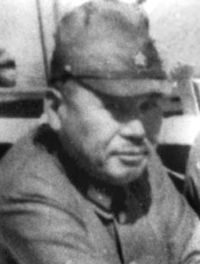- Masaji Kitano
-
Masaji Kitano 
Lieutenat General Masaji KitanoBorn July 14, 1894
Tokyo, JapanDied May 17, 1986 (aged 91)
Tokyo, JapanAllegiance Empire of Japan Service/branch  Imperial Japanese Army
Imperial Japanese ArmyYears of service 1921 -1945 Rank Lieutenant General Commands held Unit 731, Kwantung Army Battles/wars Second Sino-Japanese War
World War IIMasaji Kitano (北野政次 July 14, 1894 – May 17, 1986) was a medical doctor, microbiologist and the lieutenant general of the Imperial Japanese Army. He was the 2nd commander of Unit 731, a covert biological and chemical warfare research and development unit responsible for some of the most notorious war crimes carried out by Japanese personnel.
Biography
Kitano graduated from School of Medicine, Tokyo Imperial University in 1919 with a medical doctor degree. In 1921, he was commissioned lieutenant as an army surgeon. In 1932, he worked in the First Army Hospital in Tokyo. He later left the hospital service transferring to the Army Surgeon School. In 1936, he was dispatched to Manchukuo, part of the Empire of Japan and became a professor of Manchu School of Medicine, teaching microbiology.
In 1942, he was appointed the 2nd commander of Unit 731. His predecessor was Shiro Ishii. In April, 1945, he was promoted to lieutenant surgeon general and appointed commander of the 13th Army Medical Corps. After Japanese surrender, August 1945, he was detained in a POW camp in Shanghai. Like all involved[citation needed] with Unit 731 or Japanese biological warfare, he was repatriated to Japan in January 1946.
After he came back to Japan, he worked for Green Cross, a Japanese Pharmaceutical company. In 1959 he became head of the plant in Tokyo and the chief director of that company. He was the chief funeral commissioner of Shiro Ishii, a fellow Unit 731 member.
Kitano died in Tokyo in 1986.
Categories:- 1894 births
- 1986 deaths
- Biological warfare
- Businesspeople in the pharmaceutical industry
- University of Tokyo alumni
- Japanese military personnel of World War II
Wikimedia Foundation. 2010.
